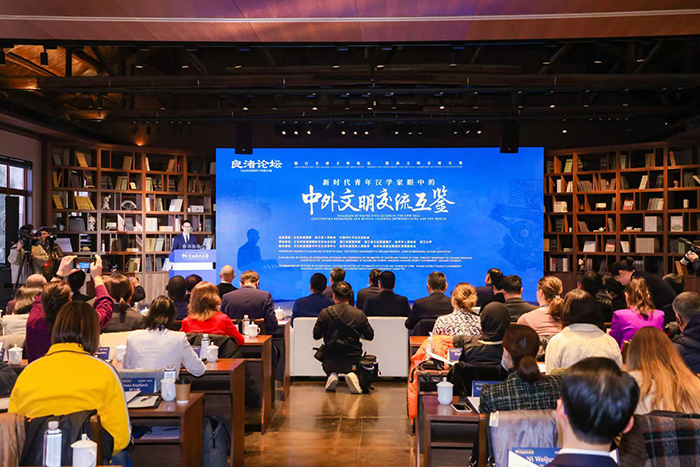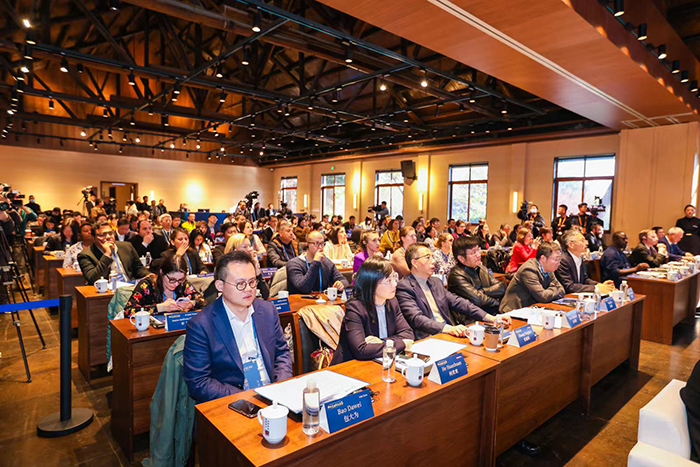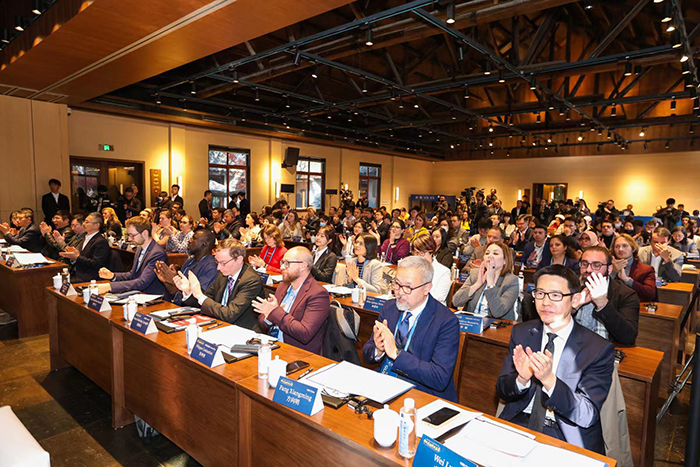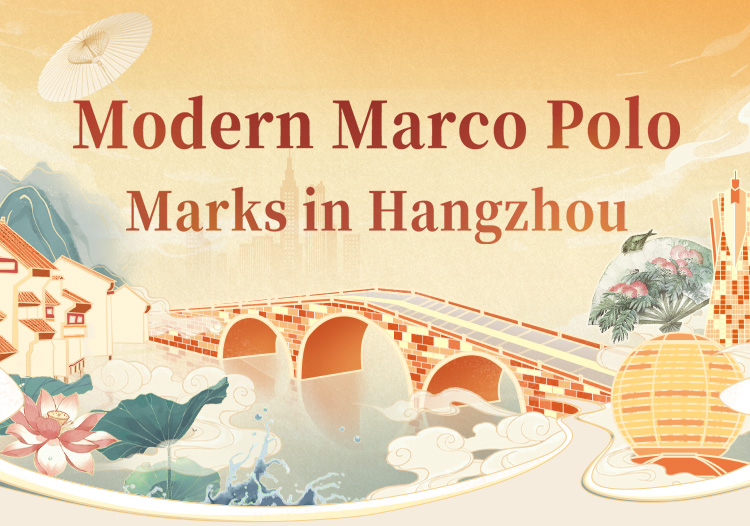
Jointly organized by Ministry of Culture and Tourism of the People’s Republic of China, the People’s Government of Zhejiang Province and China International Culture Association, Young Sinologists Sub-forum of “Liangzhu Forum” was held in Hangzhou on December 1, 2023. With the theme of “Exchange and Mutual Learning between Civilizations in the Eyes of Young Sinologists in the New Era”, the sub-forum was attended by about 150 personnel, including well-known domestic experts and scholars, such as Wang Wei and Wang Zhenzhong with Academic Divisions of Chinese Academy of Social Sciences, as well as 43 young sinologists and representatives of the media from 33 countries who participated in “2023 Young Sinologists Research Program”.
Centered on the theme of the forum, young foreign sinologists from Kazakhstan, Italy, Austria, Nigeria, Germany and other countries and domestic experts and scholars warmly discussed subjects regarding exchanges and mutual learning between civilizations in the context of “Belt and Road” Initiative, the role of “Cultural Silk Road” in promoting people-to-people exchanges and the significance of Chinese-style modernization to the world.
Wang Ting, the Deputy Director of Sino-Foreign Cultural Exchange Center of the Ministry of Culture and Tourism, quoted lines from “Book of Songs” in his MC script as saying “My guests are renown for their noble character and virtue, and amicably instruct me the great truth”. The sub-forum was a great occasion for exchange and mutual learning between Chinese civilization and the civilization of countries along the “Belt and Road”. The sub-forum aimed to give full play to the role of sinologists as a bridge, build more platforms for communication and exchange and open up dialogue based on equality and mutual trust. It will promote understanding, build up consensus and contribute wisdom and strength to mutual learning and win-win cooperation between China and the world.

Liangzhu is the priority among priorities in the project of exploring the source of Chinese civilization
“Liangzhu: the shrine that testifies 5000-year Chinese civilization”. The importance of Liangzhu is self-evident in the saying.
In his speech titled “Exchange and Mutual Learning between Civilizations in the Context of ‘Belt and Road’ Initiative”, Wang Wei, the Chief Expert in exploring the source of Chinese civilization and the Member of the Faculty of Chinese Academy of Social Sciences, said frankly: “We’ve been exploring the source of Chinese civilization for two decades and have experienced five stages since 2002. Our aim is to find answers to the questions: when did Chinese civilization come into being, how did it started and progressed, how and why did it go through such a progress. The most important of our task is to determine whether it is true or not that China really has 5000-year civilization. In this process, Liangzhu is the priority of our priorities.”
“Due to the excavation and research of Liangzhu site, we have found an early form of regional state dated back some 5000 years ago in the south and lower reaches of the Yangtze. The state was based on rice farming, was highly stratified in society and had the unified faith. This confirms the outstanding contribution of Yangtze to Chinese civilization, as was the comment of World Heritage Council when it approved the entry of Archaeological Ruins of Liangzhu City into the World Heritage List on July 6, 2019. The early form of regional state proves that Liangzhu was a civilized society,” said Wang Wei.
Wang Wei introduced the important achievements of the source exploring project from the perspective of exchange and mutual learning between civilizations. “There is one discovery that is beyond our anticipation.”
For example, there was a period when Chinese and Western civilizations exchanged frequently about 5000-4500 years ago. “For a long time, we have believed that cattle and sheep were of indigenous origin. However, ancient DNA study of the cattle and sheep that lived in central China some 4500 years ago shows that they were originated in Western Asia. The conclusion is reliable as we resorted to modern natural science and technology in the study of DNA.”
The exchange and mutual learning among civilizations is not only evidenced by the discoveries agricultural-related plants and animals, but also by modern technology. “West Asia has a long metallurgical history, as is evidenced by bronze wares and red bronze wares. The metallurgical technology was gradually spread to central Asia and northeast China (present Xinjiang, Gansu and Qinghai) some 5000 years ago.
Wang Wei also shared a series of important archaeological discoveries and the results of multidisciplinary comprehensive researches. About 5000-3000 years ago, Chinese civilization, Liangzhu civilization included, actively communicated with and learned the strength of various civilizations with distinctive features around the world. This is an important evidence that Chinese civilization is diversified, inclusive and continuous.

10000, 5000, 1000: three cultural codes of Zhejiang
In the keynote speech link, Chen Guangsheng, Director of Zhejiang Provincial Department of Culture and Tourism, delivered a keynote speech on the theme of “Zhejiang as a window to perceive Chinese civilization”. Zhejiang, where Liangzhu is located, is on the coast of vast East China Sea and has been hailed as “Land of Silk and Tea, Home to Rice and Fish, State with Profound Culture, and Tourist Resort”. Zhejiang has a complete archaeological and cultural system represented by Yishangshan, Kuanhuqiao, Hemudu, Majiabang, Liangzhu and Haochuan ruins for the period from 10,000 BC to the Bronze age.
In his speech, Chen Guangsheng shares three cultural codes that represent Zhejiang--
10,000 years ago, Zhejiang was the first in the world to cultivate rice.
“World’s earliest rice cultivation remains was found in Shangshan Ruins in Pujiang dating back to 10,000 years ago, with a complete evidence chain of rice cutting, processing and eating.” Since then, rice has been one of the staples of Chinese people and its cultural gene has subtly shaped the long course of Chinese civilization.
The poetic lines, whether “the water running northwards for the irrigation of the rice fields” in the “Book of Songs” , the “green wave of spring” “stretching to the horizon” by Wei Zhuang in the Tang Dynasty, or “water chestnuts are planted in deep water, rice grow in shallow water while lotus flowers are cultivated in between.” by Luan Yun in the Qing Dynasty, all proved the historic fact that rice was widely cultivated in China. The vigorous development of rice cultivation has been a powerful support for the continuous development of Chinese civilization.
5000 years ago, Chinese civilization dawned
“Just as dynasties and wonders of civilizations, such as Pyramid of Khufu and hanging Garden, appeared in ancient Egypt and ancient Babylon some 5000 years ago, Liangzhu in Zhejiang, an ancient city featured by three layers, palaces, inner city and outer city, had also established early regional kingship with ritual wares such as Jade Cong, Yue and Bi and developed unprecedentedly strong power of organization and production 5000 years ago,” said Chen Guangsheng.
“To sum up, Liangzhu culture is an eloquent evidence that Chinese civilization had continued and prospered for 5000 years. It’s a historic fact instead of a hearsay.”
1000 years ago, Jiangnan culture incepted.
Located in the center of Jiangnan region, Zhejiang has a history of continuous development from Yue culture, Wuyue culture to Song culture, as has been evidenced by the archaeological discoveries. “It was when Song Dynasty relocated its capital to Hangzhou some 1000 years ago that Zhejiang started to become the epitome of Jiangnan culture and the center of Chinese civilization.”
“Whether for the period from 10,000 to 5000 years ago, or from 1000 years ago to present, Zhejiang has been the best window for the world to learn China and will continue to carry forward the history and embrace a bright future through inheritance and innovation with exuberant vitality.” said Chen Guangsheng.

Liangzhu represents peace and peaceful spirit
In the themed dialogue link, young sinologists had two dialogues with Chinese experts
Wang Zhengzhong, Member of Academic Divisions of Chinese Academy of Social Sciences, and Zhang Yinglan, Professor of School of Arts and Archaeology of Zhejiang University, had a dialogue with Philippe, Professor of the School of Philosophy of the University of Costa Rica, and Sean Padraig Lysaght, Director of Confucius Institute Office of the University of Vienna, Austria, on the theme of “cultural silk road and people-to-people connection in the eyes of young sinologists”.
Wang Zhengzhong, Member of the Academic Divisions of Chinese Academy of Social Sciences, outlined that Liangzhu civilization was featured by city, rice, jade wares, texts and ancestor worship with traces of totems.
The sacrificial jade wares of Liangzhu indicate the spirit of culture or ritual. China has been known as “State of Ceremonies”. Now it seems the title has been veritable since as early as Liangzhu civilized society. This is an important feature of Liangzhu civilization, said Wang Zhenzhong.
During his speech, Wang showed a picture of a pottery pot with inscriptions of four characters. Mr. Li Xueqin, a famous paleographer in China, identified the four characters as “Wu Yue Wu Yu”. Texts are written signs of languages and signs with pronunciations shall be considered texts. Scholar and myself believe that the texts, coupled by other written materials, prove that Liangzhu had texts and that Liangzhu civilization was the one that used texts.”
Sun Yinggang, Executive Vice President of the School of History of Zhejiang University, commented that in addition to the texts, Liangzhu ruins displayed a sense of order with exquisite jade wares in a space of 2.9 million square meters, which indicated that Liangzhu advocated peace and had the ability of turning hostility into friendship. “This shows that Chinese civilization is as open as any other civilization could be in the whole history of human being.”
Zhang Yinglan, Professor of the School of Art and Archaeology of Zhejiang University, introduced the results of his study on the logic of the development and evolution of Liangzhu civilization. He believed that Liangzhu civilization was not merely an important archaeological discovery, but more importantly, it revealed the development course of Chinese and even East Asian civilizations. “Here are the four characteristics of Chinese civilization: firstly, it is ingenious; secondly, it is stable throughout the history; thirdly, it is inclusive, and fourthly, it is diversified.
With Liangzhu as topic opener, the scholars then furthered their discussions on the silk road and Sino-foreign cultural exchanges.
The ancient silk road had been a road of exchanges and communication. The introduction of different cultures played an important role in the development of Chinese culture and civilization.
“I was about to say that I was a historian, but I’ve changed my mind. I’ve realized that I’m not a historian, but a student of history, as I have more to learn,” said Sean Padraig Lysaght, Vice President of Eurasia-Pacific Uninet, Director of the Confucius Institute Office at the University of Vienna, Austria, and Lecture of Department of History at the University of Vienna.
“The Silk Road was not just about transporting goods and passengers from one end of Eurasia to the other, it’s also about something much more exciting, that is, a humanistic view of the world and a view of the humanistic world. Today, more than ever before, silk road culture is more closely connecting people of different countries and cultures. Within the framework of this initiative, cultural and people-to-people exchanges are promoted and become more important.”

Chinese modernization: promoting civilization interchange
In the second thematic dialogue, Wei Lu, Dean of the School of Media and International Culture of Zhejiang University, and He Huanhuan, Professor of the School of Philosophy of Zhejiang University, had a dialogue with Sharif, Dean of the Department of Political and International Relations of the University of Abuja in Nigeria, and Dr. Hannes Jedeck, Executive Director of the Confucius Institute of the University of Bonn in Germany, on “Chinese-style modernization and its world significance in the eyes of young sinologists”.
In his speech, Wei Lu said: “in retrospect of the development course of human society, we’ve already experienced primitive civilization, agricultural civilization and industrial civilization. Now, we at the crossing where industrial civilization will continue while new technologies marked by artificial intelligence have emerged and may lead the global community towards a smart civilization.”
After analyzing the five problems facing China’s international communication, he proposed that efforts should be made to tell Chinese stories better through more diversified subjects and contents, more people-oriented narration, intelligent media and personalized content production in communication.
Bao Dawei, a research fellow of the “Hundred People Program” at the School of Marxism of Zhejiang University and the emcee of the sub-forum, pointed out that as language translations become increasingly convenient especially with development of artificial intelligence, it remains difficult to translate outstanding Chinese traditional culture to the understanding of modern people.
“As we can see, cultural relics and historic sites are silent and do not speak for themselves. Therefore, one of the important things we should do is to translate the traditional culture into a language that is readable by modern people in China and around the world. This requires to introduce a symbol system into the traditional culture.”
Sharif, head of Department of Political and International Relations at the University of Abuja in Nigeria, said: “everyone can be an important channel and member in the interconnection, communication and mutual learning of various cultures. Each one of us, like a brick, may make due contribution to the construction wherever necessary. This is true for Chinese culture as well as for all cultures.”


